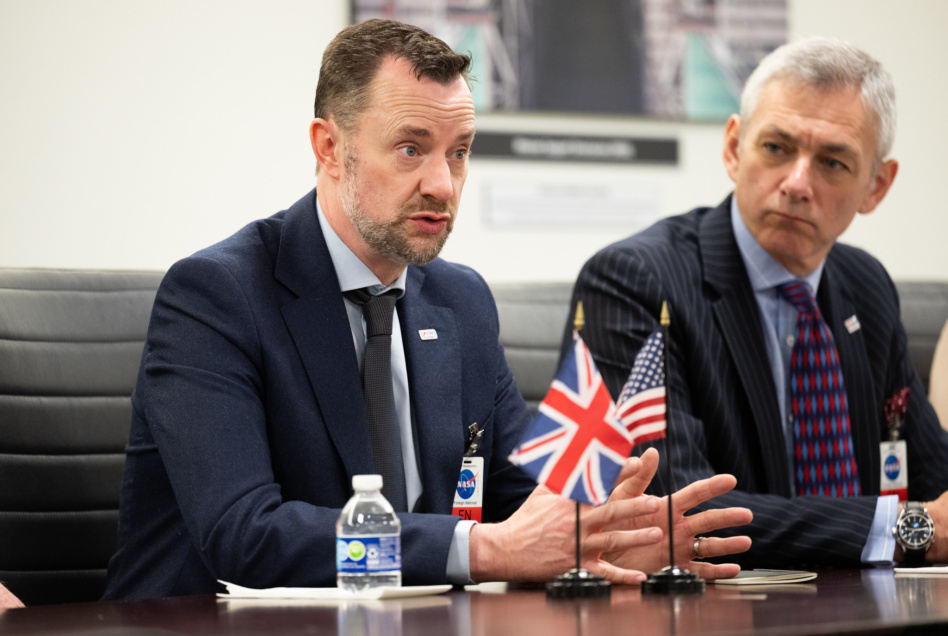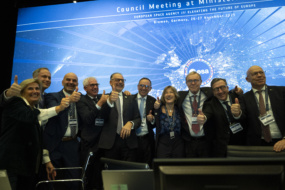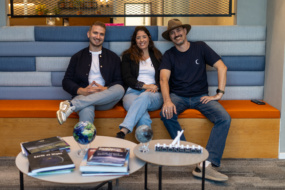The UK Space Agency challenged industry in January to extract and purify water ice on the Moon—and so far, companies have come forward in droves with ideas to solve the problem, according to the agency’s CEO.
The Aqualunar Challenge, launched in partnership with the Canadian Space Agency, offers companies a combined pot of ~$2.5M for developing tech to access water frozen on the lunar South Pole.
“One thing we wanted to do was to innovate on the way in which the money was being provided. So doing it as a challenge as opposed to more traditional grant funding, the reception to it was very healthy,” UKSA CEO Paul Bate told Payload. “I’m very, very happy to see how many people have stepped forward.”
As for the focus on the Moon, Bate said the agency sees a lot of scientific value on Earth’s biggest satellite—but also argued it’s poised to propel humanity further into the cosmos.
“It’s a really important stepping stone to robotic and human exploration of Mars,” he said.
Payload caught up with Bate on the sideline of Space Symposium to talk about the agency’s new HQ, working with Axiom, and nuclear power’s potential in orbit.
This transcript has been edited for length and clarity.
How did the Aqualunar Challenge with the Canadian Space Agency come to be?
We have quite a long standing and very valued relationship with the space agency, and obviously very strong ties between the countries. We both have strong interest in exploration, including looking around for water ice that can be used effectively, safely, and sustainably.
One thing we wanted to do was to innovate on the way in which the money was being provided. So doing it as a challenge as opposed to more traditional grant funding, the reception to it was very healthy. I’m very, very happy to see how many people have stepped forward.
I think it’s important particularly on moonshot missions where there’s all sorts of different technologies and innovation brought to bear. If we knew the answers, we wouldn’t need to do this. It’s a really interesting way of funding to stimulate creativity, because I’m expecting us to see all sorts of different technologies, but also, I’m hoping for non-traditional players.
Why did you decide to focus specifically on the water ice question?
The fuel element is very important, as is the separation of oxygen as well, and the water in itself for habitation. So lots of really important things suddenly become possible.
We’ve always done our exploration as part of international collaborations. We work a lot through the European Space Agency. We are a founding member and the fourth biggest contributor. But we also very actively wanted to explore bilateral relationships. So when we find like minded countries, we will look for joint areas of scientific exploration, which takes us back to Canada.
We recognize the scientific potential of having water ice, particularly at the South Pole, which enables a very, very different form of exploration than what’s been achieved in the past. It’s safe to say that it’s the crowning jewel of humanity to have set foot on another celestial body, but the Artemis program is very different in scale than anything that Apollo was capable of achieving.
We’ve done a lot of work with NASA and other partners looking at the Artemis, but also the Moon to Mars program. So we see the Moon as very valuable in its own right, scientifically, and from an exploration point of view, but also it’s a really important stepping stone to robotic and human exploration of Mars.
The UK Space Agency recently announced a partnership with Rolls Royce to create a space nuclear reactor. What’s your reason to invest in that part of the commercial space sector?
We see three really important uses for science and exploration around nuclear fission in one form or another.
One is space batteries. The ability to keep rovers warm particularly when solar is not available is hugely valuable. We’ve invested over £20M now in being able to extract an isotope and turning it into useful space batteries for keeping things warm and providing low amounts of power to satellite systems.
On the reactor side, we see two really important exploration use cases. One being for lunar surface power and in the future, other offworld venues and locations. Dealing, for example, with the lunar night—so we’re talking about two weeks out of every four being in darkness where solar batteries are not going to cut it. That’s one area where we are investing with Rolls Royce.
The other one, which is a related technology, is the propulsion systems. It’s currently taking around nine months to go from Earth to Mars, which is right on the edge of what a human body can withstand. Cutting down the transit time is very important. We’re looking at nuclear electric propulsion, so converting the nuclear reaction into electrical power and then using that to ionize the gasses to get out the back of the rocket and move faster in the other direction.
Both cases require an extremely secure, safe system that is capable of creating nuclear fission in a controlled manner and converting that into electricity. That’s really where Rolls Royce comes in.
And it’s worth saying that the UK and the US have a 50-year, if not more, collaboration in nuclear technologies for our nuclear submarine program, which Rolls Royce also runs. So they’re a natural partner, and it’s naturally an area we wanted to explore.
Your agency is moving its HQ—why?
We are moving our headquarters to Harwell in Oxfordshire. It’s a very beautiful part of the world. But more importantly, it is an absolute hub for science and technology. There are more than 100 space companies on site already, in addition to quantum technologies and life science technologies. There are thousands of scientists and engineers working collaboratively.
The really great thing about it is it’s a joint public and private endeavor, which sounds quite unusual. We often see these industrial complexes for a particular company, but we think it is very unusual and positive to have this cross fertilization across the private and public sectors. And we really want that to be seen as a gateway for space in the UK.
If we’re serious about that, what better can we do than to move our headquarters to Harwell?
What’s the status of your agreement for a crewed flight with Axiom?
We know that there’s obviously a lot of public excitement and interest—and rightly so—in crewed spaceflight. We also are very clear on the value of the science and technology development, and the ability to do outreach for children and adults on the possibilities of space and the the learning that we can get from space missions.
But the truth is, it’s expensive launching astronauts. So when Axiom approached us last year with the idea that an all-UK mission crewed entirely by UK astronauts could be funded through commercial sponsorship, and that they believed it was the right sort of country to be able to make that possible, we were very interested.
We came to the conclusion that it was viable, which led to the signing of the memorandum of understanding between the space agency and Axiom last year, to give the ability for Axiom to explore with commercial sponsors, which they’ve been doing.
We were very clear that any mission has to have clear science and technology development goals, or goals. So a month or two back we launched a call for proposals to the scientific intelligence community for £15M for experiments.
That £15M call will be funded through a commercial funding route. We could have waited and said, well, let’s work everything out first. However, we were much keener to launch the call, though we caveat it to everyone that the money has to flow and be paid for commercially, not paid for by taxpayers. But it’s that sort of activity that I think makes the mission more likely to happen.
How much interest have you seen so far from companies looking to sponsor the mission?
We’ve seen a lot of interest, and I really don’t want to get into any details of particular deals. But absolutely. We’ve supported Axiom in a number of conversations, they unambiguously lead on those conversations. But yes, I think it’s safe to say, across multiple different sectors, there are companies who at the least say they are interested in what space can do for them.




